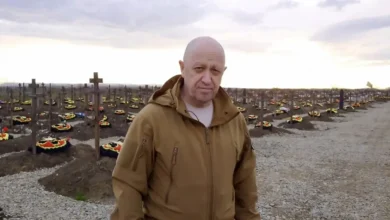The choir helping people reclaim the voices they lost to cancer

It is a sunny day in early April, and a performance is under way in a gleaming concert hall in central London. A gentle crackling and clanking, echoing as if trapped in the hull of a ship, fills the room. These are the sounds of the swaying, creaks and groans of the trees that survived the Hiroshima and Nagasaki nuclear bombings.
The four singers on stage, all men in their 70s and 80s and dressed in black, start to riff along, adding tongue clicks and tut-tuts to the music of the trees, some pressing a finger to what looks like a large button on their throat. Projected onto a large screen behind them are ethereal images of the arboreal survivors.The pace and volume increase alongside a collection of eclectic instruments: an electric guitar, a cello bow, an accordion, drums, the sound of B29 bomber engines and morse code, and the rattling of a Turkish coffee tin filled with rocks.
Then, the singers break into a refrain, in a loud, hoarse whisper that rings with a metallic reverberation: “Set your words free. Set your words free. Set your words free.”
It hits like a gentle electric current, unexpected and powerful. The singers onstage are cancer survivors who have had their larynx, or voice box, removed as part of life-saving surgery known as a laryngectomy, and use medical devices to recreate the voices they lost. They are singing to say that they do not plan to live in silence.To allow patients to speak, a voice prosthesis, comprised of a valve, is often inserted to connect the windpipe in the throat to the oesophagus, which carries food from the mouth to the stomach.
The prosthesis works by blocking the stoma button on the neck with a finger to force air to travel through this valve to produce a vibration in the oesophagus. The speech it produces is raspy but usually retains one’s accent. While the prosthesis is expensive and requires replacing at least twice a year, as well as extensive training with a speech therapist to master it, the device is considered the gold standard for articulation.
Another option is oesophageal speech where no valve is required and patients learn to swallow the air into the upper oesophagus to create a vibration, which gives a relatively short ability to voice words with a monotonous sound. Alternatively, the electrolarynx, an instrument which is held to the neck, produces an external vibration that results in a robotic sound, which is much harder for patients to adjust to mentally.Perhaps because the disease and the treatment affect vital functions like breathing, eating and communication, studies have found that patients with head and neck cancers report the highest levels of anxiety compared with other cancer types, with almost 40 percent suffering from depression and social isolation. Many struggle with disfigurement or see significant changes in their sense of taste.
“It’s not just the voice that’s gone. It’s the smell, it’s the swallowing that’s affected,” says Thomas Moors, an ear, nose and throat (ENT) doctor at Lancashire Teaching Hospitals in the United Kingdom. “It’s a huge impact on their personalities.”










